|
| ||
| Green on the menu
by Ari LeVaux
Chlorophyll is thought to be a “blood building” nutrient because it’s freakishly similar in structure to hemoglobin, the oxygen-carrying molecule in blood. Other healthful properties attributed to chlorophyll include enhanced healing of wounds (and suppression of foul odors coming from wounds), cancer-fighting qualities, protection from radiation, and speeding of bone healing and tissue regeneration. Small baby spinach leaves are the rage, but they don’t pack the same wallop as a big leaf of savoy spinach, also known as crinkled or curly leaf, like Tyee or Bloomsdale. The leaves are bigger, thicker, and make a bold and juicy mouthful. Unfortunately, most of what’s available in stores are the flat, smooth-leaf varieties that lend themselves to mass cultivation. The whole plant is harvested, bunched with other plants, packed into crates and delivered to your store. Savoy is generally sold loose-leaf, or picked as needed if it’s growing outside. In keeping with the sushi-like feeling that raw spinach imparts, I like to dress my spinach leaves in a mixture of soy sauce, wasabi, rice vinegar, and a few drops each of limejuice and sesame oil. Or, for a fun appetizer, dip the leaves into the dressing like chips into salsa; the crinkly folds grip the sauce.If you have a lot of spinach, saag paneer is a great option. This classic Indian dish is made with homemade cheese, though some people make it with tofu instead of cheese, which is totally weak – if you don’t want cheese, fine, but don’t bother searching for some other chunky white protein. Other spring greens can be used in addition to or instead of spinach, including turnip greens, kale, wild nettles, overwintering mustard greens, dandelion, lambs quarter and other edible weeds. Some aficionados swear that saag paneer isn’t right if it doesn’t contain mustard greens as well as spinach. The dish needs tomatoes in order to taste right. You can use fresh tomatoes, and I’ll do so when I make saag paneer with fall spinach, but I think homemade catsup is the best. It has a sweet, clove flavor that goes beautifully with the spices, and its perfect smoothness gives body to the green mush. The process begins with the making of the cheese, aka paneer. Heat half a gallon of whole milk on med/high in a thick-bottomed pan, stirring often with a rubber spatula or similar implement to prevent scalding the milk. You have to be vigilant, because mere seconds will pass between when the milk is almost boiling and when it’s boiling over into a frothy, foamy mess. As soon as it begins to boil, turn off the heat and add four tablespoons of lemon juice, stirring steadily. The milk should separate into watery whey with thick curds floating on top. If the whey still appears creamy, add another tablespoon of lemon juice. Lay at least four layers of cheesecloth into a colander set inside a big bowl and pour the curdled milk through the cheesecloth. The whey can be used for other cooking purposes or fed to animals. Tie the corners of the cheesecloth together and hang over the whey bowl so it continues draining and the curds settle into a hard cheese. Squeeze the curds to get more whey out.Now wash your spinach and/or other greens. While spinach stems are tender enough to leave in, tougher stems like from kale, nettles or mustard greens should be removed. For each half-pound of greens, chop one or two serrano or jalapeño peppers and a teaspoon of ginger. Cook the peppers and ginger for a few minutes in a quarter-inch of water. Add a half-teaspoon of salt, then add the greens. Put a lid on and cook for five minutes, stirring occasionally and being careful not to let the water evaporate. Let the greens cool, then puree in a blender. Cut your cheese into cubes and lightly brown them in a hot pan with oil or ghee. The browning brings out a nutty flavor. Set aside the browned cheese. In a pan with oil or ghee (or mustard oil) on medium heat, add a pinch of fenugreek seeds, a pinch of cumin powder, and a pinch or more of coriander, and cook for 30 seconds. Add an onion, chopped, and your tomato product: either a fresh tomato, minced, or a quarter cup catsup or half a cup canned tomatoes, and one or two chopped garlic cloves. Cook until it’s integrated and soupy. Then add the cheese and stir-fry until the cheese heats up. Then add the pureed greens. Let it cook together for a few minutes, and it’s done. Saag paneer is typically served with an aromatic rice, like basmati or jasmine. And the green, chlorophyll cream can also be made in bulk, when spinach is plentiful, and frozen in meal-sized portions for later use. It ages nicely. Which is more than you can say about sushi. •
|



 Good spinach is the beef of plants. It has a meaty vibe and can get you a little high, the way sushi can. I think this green fleshy feeling is related to the extreme chlorophyll density in spinach, and because the plant’s tender, watery build makes this chlorophyll unusually accessible.
Good spinach is the beef of plants. It has a meaty vibe and can get you a little high, the way sushi can. I think this green fleshy feeling is related to the extreme chlorophyll density in spinach, and because the plant’s tender, watery build makes this chlorophyll unusually accessible.